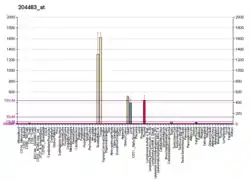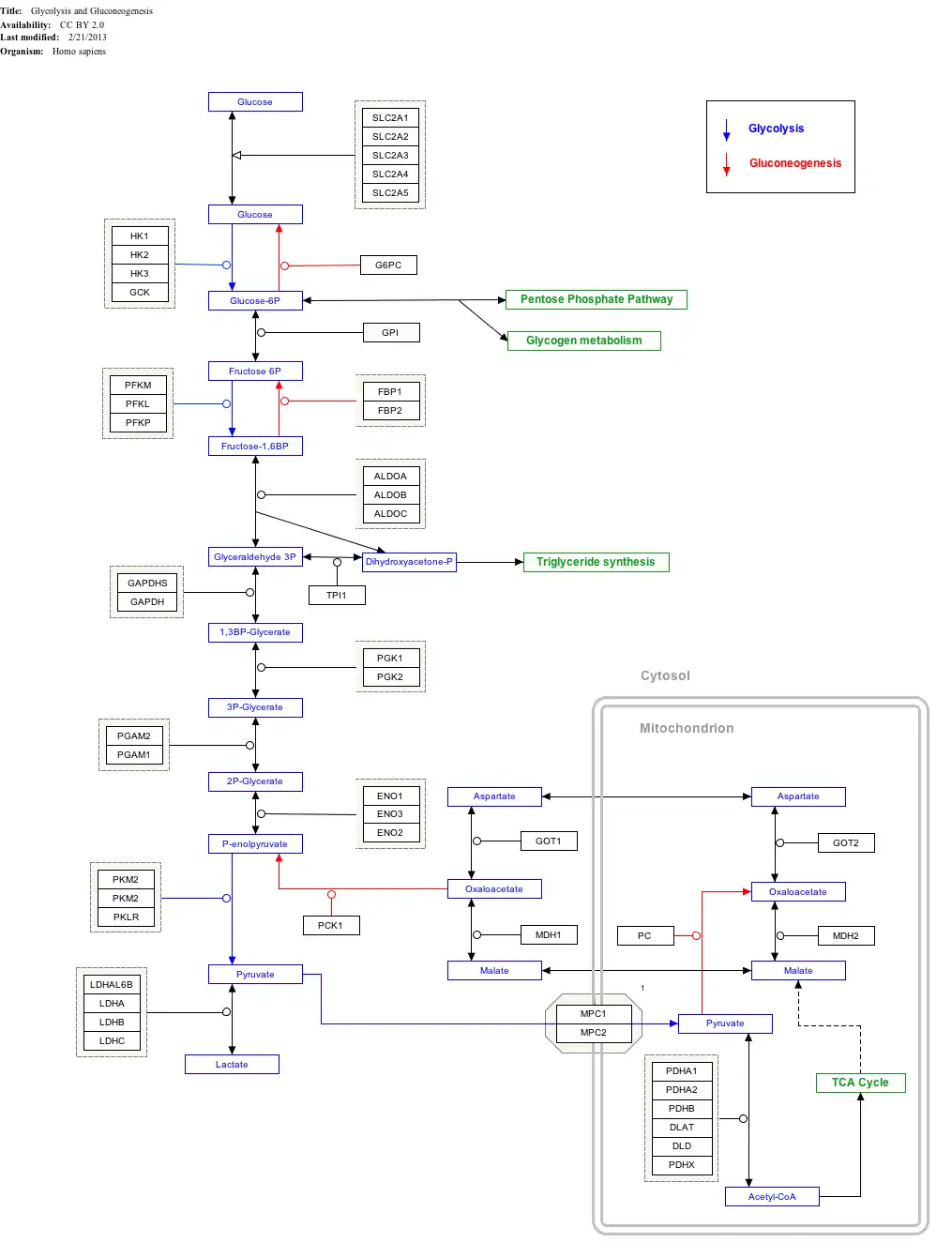ENO3
Enolase 3 (ENO3), more commonly known as beta-enolase (ENO-β), is an enzyme that in humans is encoded by the ENO3 gene.
| ENO3 | |||||||||||||||||||||||||||||||||||||||||||||||||||
|---|---|---|---|---|---|---|---|---|---|---|---|---|---|---|---|---|---|---|---|---|---|---|---|---|---|---|---|---|---|---|---|---|---|---|---|---|---|---|---|---|---|---|---|---|---|---|---|---|---|---|---|
| |||||||||||||||||||||||||||||||||||||||||||||||||||
| Identifiers | |||||||||||||||||||||||||||||||||||||||||||||||||||
| Aliases | ENO3, GSD13, MSE, enolase 3 | ||||||||||||||||||||||||||||||||||||||||||||||||||
| External IDs | OMIM: 131370 MGI: 95395 HomoloGene: 68215 GeneCards: ENO3 | ||||||||||||||||||||||||||||||||||||||||||||||||||
| |||||||||||||||||||||||||||||||||||||||||||||||||||
| |||||||||||||||||||||||||||||||||||||||||||||||||||
| |||||||||||||||||||||||||||||||||||||||||||||||||||
| |||||||||||||||||||||||||||||||||||||||||||||||||||
| |||||||||||||||||||||||||||||||||||||||||||||||||||
| Wikidata | |||||||||||||||||||||||||||||||||||||||||||||||||||
| |||||||||||||||||||||||||||||||||||||||||||||||||||
This gene encodes one of the three enolase isoenzymes found in mammals. This isoenzyme is found in skeletal muscle cells in the adult where it may play a role in muscle development and regeneration. A switch from alpha enolase to beta enolase occurs in muscle tissue during development in rodents. Mutations in this gene have been associated with glycogen storage disease. Alternatively spliced transcript variants encoding different isoforms have been described.[provided by RefSeq, Jul 2010][5]
Structure
ENO3 is one of three enolase isoforms, the other two being ENO1 (ENO-α) and ENO2 (ENO-γ).[6][7] Each isoform is a protein subunit that can form hetero- or homodimers of the following combinations: αα, αβ, αγ, ββ, and γγ.[8][9][10]
Gene
The ENO3 gene spans 6 kb and contains 12 exons, though the first exon is an untranslated region and, thus, non-coding. This first intron, along with the 5'-flanking region, contains a consensus sequence for muscle-specific regulatory factors that includes a CC(A + T-rich)6GG box, a M-CAT-box CAATCCT, and two myocyte-specific enhancer-binding factor 1 boxes.[7][10] Upstream of the first exon lies a TATA-like box and CpG-rich region, which contains recognition motifs for binding transcriptional regulatory factors such as Sp1, activator protein 1 and 2, CCAAT box transcription factor/nuclear factor I, and cyclic AMP.[7] Unlike the other enolase genes, which possess multiple transcription initiation sites, ENO3 possesses a single initiation site located 26 bp downstream of the TATA-like box.[10]
Function
As an enolase, ENO3 is a glycolytic enzyme that catalyzes the reversible conversion of 2-phosphoglycerate to phosphoenolpyruvate.[7][8] This particular isoform is predominantly expressed in adult striated muscle, including skeletal and cardiac muscle.[6][7][10] During fetal muscle development, there is a transcriptional switch from expressing ENO1 to ENO3 influenced by muscle innervation and Myo D1.[7][10] ENO3 is expressed at higher levels in fast-twitch fibers than in slow-twitch fibers.[10]
Clinical significance
ENO3 has been associated with energy metabolism in cancer cells. TFG-TEC, an oncoprotein, activates ENO3 expression by altering the chromatin structure of the ENO3 promoter and increasing the acetylation of histone H3.[8]
Muscle β-enolase deficiency (glycogen storage disease type XIII) is a rare inherited metabolic myopathy caused by a defect in the enzyme's active site, thus disrupting its glycolytic activity. Though this deficiency is characterized as an autosomal recessive condition, both heterozygous and homozygous mutations were identified in the ENO3 gene. The heterozygous mutations were linked to milder symptoms while the homozygous mutations tended to produce more severe symptoms, including rhabdomyolysis. Advances in genetic testing, such as exome sequencing and specific gene panels, can provide greater access to diagnoses for muscle β-enolase deficiency and other rare disorders.[9]
Interactions
TFG-TEC binds to the proximal promoter region of the ENO3 gene.[8]
Interactive pathway map
Click on genes, proteins and metabolites below to link to respective articles.[§ 1]
- The interactive pathway map can be edited at WikiPathways: "GlycolysisGluconeogenesis_WP534".
See also
References
- GRCh38: Ensembl release 89: ENSG00000108515 - Ensembl, May 2017
- GRCm38: Ensembl release 89: ENSMUSG00000060600 - Ensembl, May 2017
- "Human PubMed Reference:". National Center for Biotechnology Information, U.S. National Library of Medicine.
- "Mouse PubMed Reference:". National Center for Biotechnology Information, U.S. National Library of Medicine.
- "ENO3 enolase 3 (beta, muscle)". NCBI Entrez Gene database.
- Zhu X, Miao X, Wu Y, Li C, Guo Y, Liu Y, Chen Y, Lu X, Wang Y, He S (Jul 2015). "ENO1 promotes tumor proliferation and cell adhesion mediated drug resistance (CAM-DR) in Non-Hodgkin's Lymphomas". Experimental Cell Research. 335 (2): 216–23. doi:10.1016/j.yexcr.2015.05.020. PMID 26024773.
- Peshavaria M, Day IN (Apr 1991). "Molecular structure of the human muscle-specific enolase gene (ENO3)". The Biochemical Journal. 275 (2): 427–33. doi:10.1042/bj2750427. PMC 1150071. PMID 1840492.
- Kim AY, Lim B, Choi J, Kim J (Aug 2015). "The TFG-TEC oncoprotein induces transcriptional activation of the human β-enolase gene via chromatin modification of the promoter region". Molecular Carcinogenesis. 55 (10): 1411–1423. doi:10.1002/mc.22384. PMID 26310886. S2CID 25167240.
- Musumeci O, Brady S, Rodolico C, Ciranni A, Montagnese F, Aguennouz M, Kirk R, Allen E, Godfrey R, Romeo S, Murphy E, Rahman S, Quinlivan R, Toscano A (Dec 2014). "Recurrent rhabdomyolysis due to muscle β-enolase deficiency: very rare or underestimated?". Journal of Neurology. 261 (12): 2424–8. doi:10.1007/s00415-014-7512-7. PMID 25267339. S2CID 20446106.
- Giallongo A, Venturella S, Oliva D, Barbieri G, Rubino P, Feo S (Jun 1993). "Structural features of the human gene for muscle-specific enolase. Differential splicing in the 5'-untranslated sequence generates two forms of mRNA". European Journal of Biochemistry. 214 (2): 367–74. doi:10.1111/j.1432-1033.1993.tb17932.x. PMID 8513787.
Further reading
- Peshavaria M, Day IN (Apr 1991). "Molecular structure of the human muscle-specific enolase gene (ENO3)". The Biochemical Journal. 275 (2): 427–33. doi:10.1042/bj2750427. PMC 1150071. PMID 1840492.
- Calì L, Feo S, Oliva D, Giallongo A (Apr 1990). "Nucleotide sequence of a cDNA encoding the human muscle-specific enolase (MSE)". Nucleic Acids Research. 18 (7): 1893. doi:10.1093/nar/18.7.1893. PMC 330616. PMID 2336366.
- Peshavaria M, Hinks LJ, Day IN (Nov 1989). "Structure of human muscle (beta) enolase mRNA and protein deduced from a genomic clone". Nucleic Acids Research. 17 (21): 8862. doi:10.1093/nar/17.21.8862. PMC 335055. PMID 2587223.
- Giallongo A, Venturella S, Oliva D, Barbieri G, Rubino P, Feo S (Jun 1993). "Structural features of the human gene for muscle-specific enolase. Differential splicing in the 5'-untranslated sequence generates two forms of mRNA". European Journal of Biochemistry. 214 (2): 367–74. doi:10.1111/j.1432-1033.1993.tb17932.x. PMID 8513787.
- Comi GP, Fortunato F, Lucchiari S, Bordoni A, Prelle A, Jann S, Keller A, Ciscato P, Galbiati S, Chiveri L, Torrente Y, Scarlato G, Bresolin N (Aug 2001). "Beta-enolase deficiency, a new metabolic myopathy of distal glycolysis". Annals of Neurology. 50 (2): 202–7. doi:10.1002/ana.1095. PMID 11506403. S2CID 21913565.
- Li TB, Liu XH, Feng S, Hu Y, Yang WX, Han Y, Wang YG, Gong LM (Jun 2004). "Characterization of MR-1, a novel myofibrillogenesis regulator in human muscle". Acta Biochimica et Biophysica Sinica. 36 (6): 412–8. doi:10.1093/abbs/36.6.412. PMID 15188056.
- Kimura K, Wakamatsu A, Suzuki Y, Ota T, Nishikawa T, Yamashita R, Yamamoto J, Sekine M, Tsuritani K, Wakaguri H, Ishii S, Sugiyama T, Saito K, Isono Y, Irie R, Kushida N, Yoneyama T, Otsuka R, Kanda K, Yokoi T, Kondo H, Wagatsuma M, Murakawa K, Ishida S, Ishibashi T, Takahashi-Fujii A, Tanase T, Nagai K, Kikuchi H, Nakai K, Isogai T, Sugano S (Jan 2006). "Diversification of transcriptional modulation: large-scale identification and characterization of putative alternative promoters of human genes". Genome Research. 16 (1): 55–65. doi:10.1101/gr.4039406. PMC 1356129. PMID 16344560.





